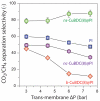Metal-organic framework nanosheets in polymer composite materials for gas separation
- PMID: 25362353
- PMCID: PMC4270742
- DOI: 10.1038/nmat4113
Metal-organic framework nanosheets in polymer composite materials for gas separation
Abstract
Composites incorporating two-dimensional nanostructures within polymeric matrices have potential as functional components for several technologies, including gas separation. Prospectively, employing metal-organic frameworks (MOFs) as versatile nanofillers would notably broaden the scope of functionalities. However, synthesizing MOFs in the form of freestanding nanosheets has proved challenging. We present a bottom-up synthesis strategy for dispersible copper 1,4-benzenedicarboxylate MOF lamellae of micrometre lateral dimensions and nanometre thickness. Incorporating MOF nanosheets into polymer matrices endows the resultant composites with outstanding CO2 separation performance from CO2/CH4 gas mixtures, together with an unusual and highly desired increase in the separation selectivity with pressure. As revealed by tomographic focused ion beam scanning electron microscopy, the unique separation behaviour stems from a superior occupation of the membrane cross-section by the MOF nanosheets as compared with isotropic crystals, which improves the efficiency of molecular discrimination and eliminates unselective permeation pathways. This approach opens the door to ultrathin MOF-polymer composites for various applications.
Figures






References
-
- Stankovich S, et al. Graphene-based composite materials. Nature. 2006;442:282–286. - PubMed
-
- Wang QH, Kalantar-Zadeh K, Kis A, Coleman JN, Strano MS. Electronics and optoelectronics of two-dimensional transition metal dichalcogenides. Nat Nanotechnol. 2012;7:699–712. - PubMed
-
- Choi S, et al. Layered silicates by swelling of AMH-3 and nanocomposite membranes. Angew. Chem. Int. Ed. Engl. 2008;47:552–555. - PubMed
-
- Varoon K, et al. Dispersible exfoliated zeolite nanosheets and their application as a selective membrane. Science. 2011;334:72–75. - PubMed
-
- Corma A, Fornes V, Pergher SB, Maesen Th. L. M., Buglass JG. Delaminated zeolite precursors as selective acidic catalysts. Nature. 1998;396:353–356.
Publication types
Grants and funding
LinkOut - more resources
Full Text Sources
Other Literature Sources
Research Materials

